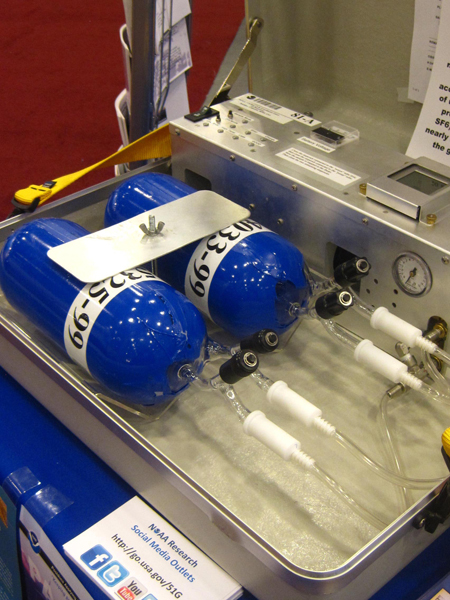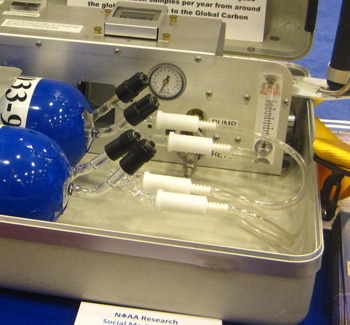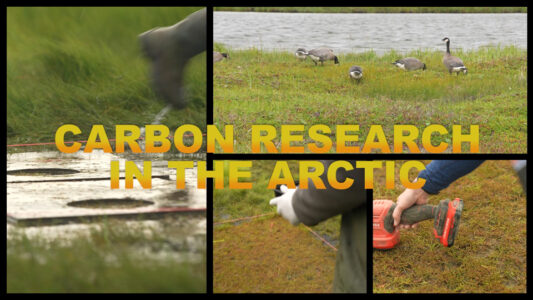Laura Nielsen for Frontier Scientists.
Volunteers across the world are participating in a global air sampling network run by by NOAA, the National Oceanic and Atmospheric Administration, to monitor greenhouse gasses in the atmosphere.
This cooperative network, consisting of over 50 global locations, sends air samples weekly to a central lab in Boulder, Colorado. From there the samples are tested and analyzed for Carbon Dioxide (CO2) and other greenhouse gases ( Carbon Monoxide (CO), Methane (CH4), Nitric oxide (NO), Hydrogen (H2), and Sulphur hexafluoride (SF6) ), and for over 50 other trace gases and isotopes.
That data is obtained through testing ambient air (the air humans breathe every day) which is composed of about 78% Nitrogen, 21% Oxygen, and 1% of CO2, Argon, and many other trace gases. It is the last 1% which gives the most tantalizing data. Air is secured inside flasks and shipped to the lab for testing.
The portable sampling unit used to take samples is contained within a silver case which looks like it belongs to a suave air-sampling secret agent. When set up, it pulls air simultaneously into two flasks with a pump and air intake tubing, all at the flip of a switch. The volunteers who take the air samples follow specific instructions regarding use of the unit and prescribed distance from vehicles, animals, and other possible local pollutants. The weekly samples are shipped to the Carbon Cycle Greenhouse Gas (CCGG) group’s Boulder Central Facility for testing.
Shipping the glass air flasks safely isn’t easy; they are labeled, protected by tape, plastic, baked-on insulated coating, and special shipping boxes. Nearly 20,000 samples are analyzed yearly by the Global Monitoring Division. The data from each site, after being input into a relational database, goes toward crafting the Global Carbon Dioxide Record.
The Earth System Research Laboratory’s Global Monitoring Division site has a map detailing every current and past testing location. One is even in Ulaan Uul, Mongolia, from whence the sampling volunteer must take a 10-hour train ride to send the packaged air flasks on their way back to Colorado.
Collected alongside all of these measurements taken via surface flasks are measurements obtained through different means. The CCGG group collects measurements from NOAA observatories which take continuous readings, from sensors located atop tall towers, and from automated collections attached to aircraft. Through these means, they monitor and map the levels of greenhouse gas concentrations at different locations and different altitudes across the globe.
After samples have been analyzed by CCGG for greenhouse gasses CO2, CH4, CO, H2, N2O, and SF6, they are tested by INSTAAR for the stable isotopes of CO2 and CH4 as well as for volatile organic compounds like Ethane (C2H6), Ethylene (C2H4) and Propane (C3H8). The information uncovered is used to map long-term data trends, distribution, and seasonal differences in the amount of carbon cycle gases in the atmosphere across the world. It aids in testing the quality of the air we breathe and in understanding climate change and ozone depletion through hard data.
The Carbon Cycle Greenhouse Gas group is part of the Global Monitoring Division branch at NOAA’s Earth Systems Research Laboratory in Boulder, Colorado.
FrontierScientists attended the American Geophysical Union Fall Meeting 2011.
References:
Earth System Research Laboratory : Global Monitoring Division

















